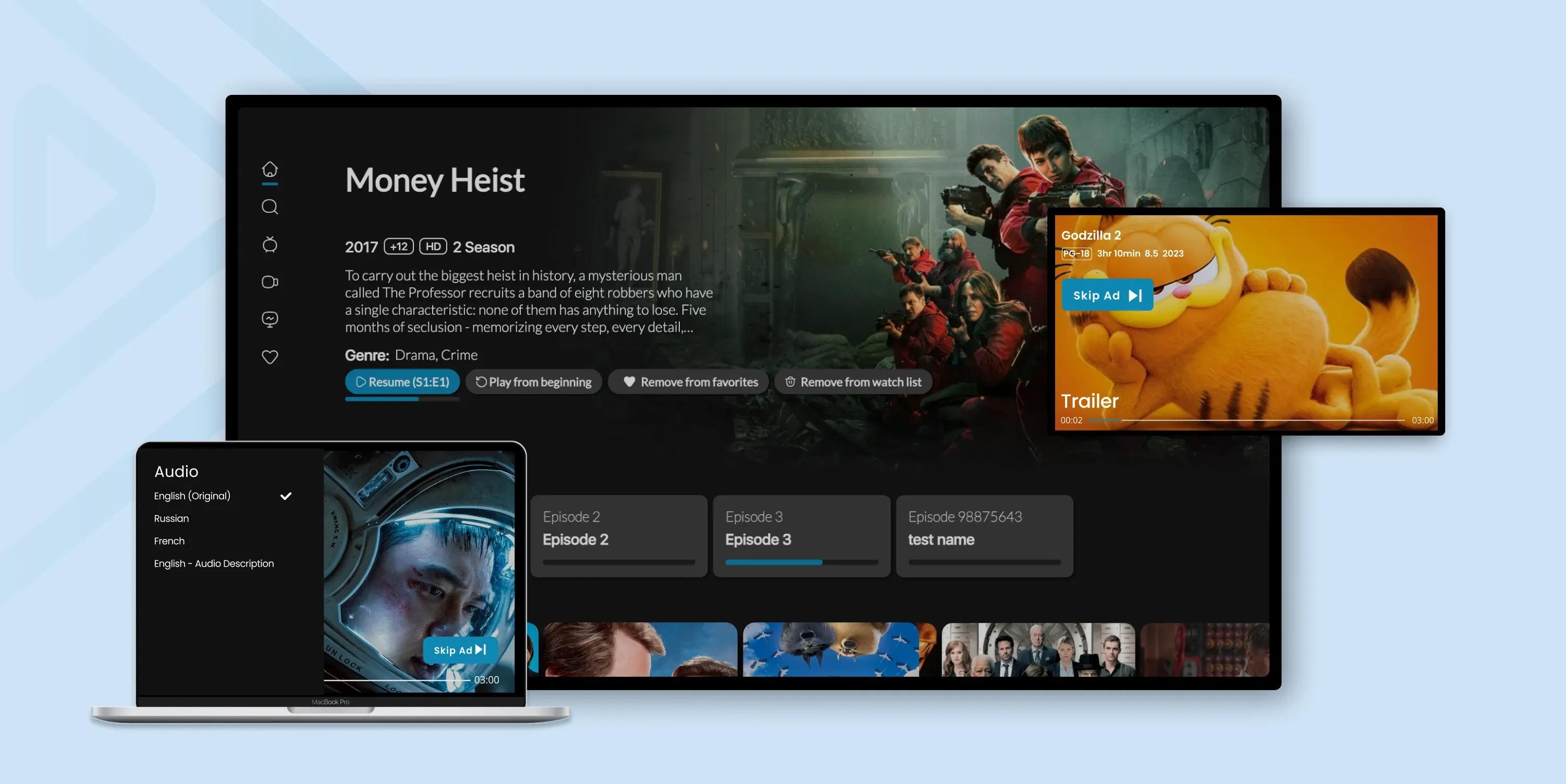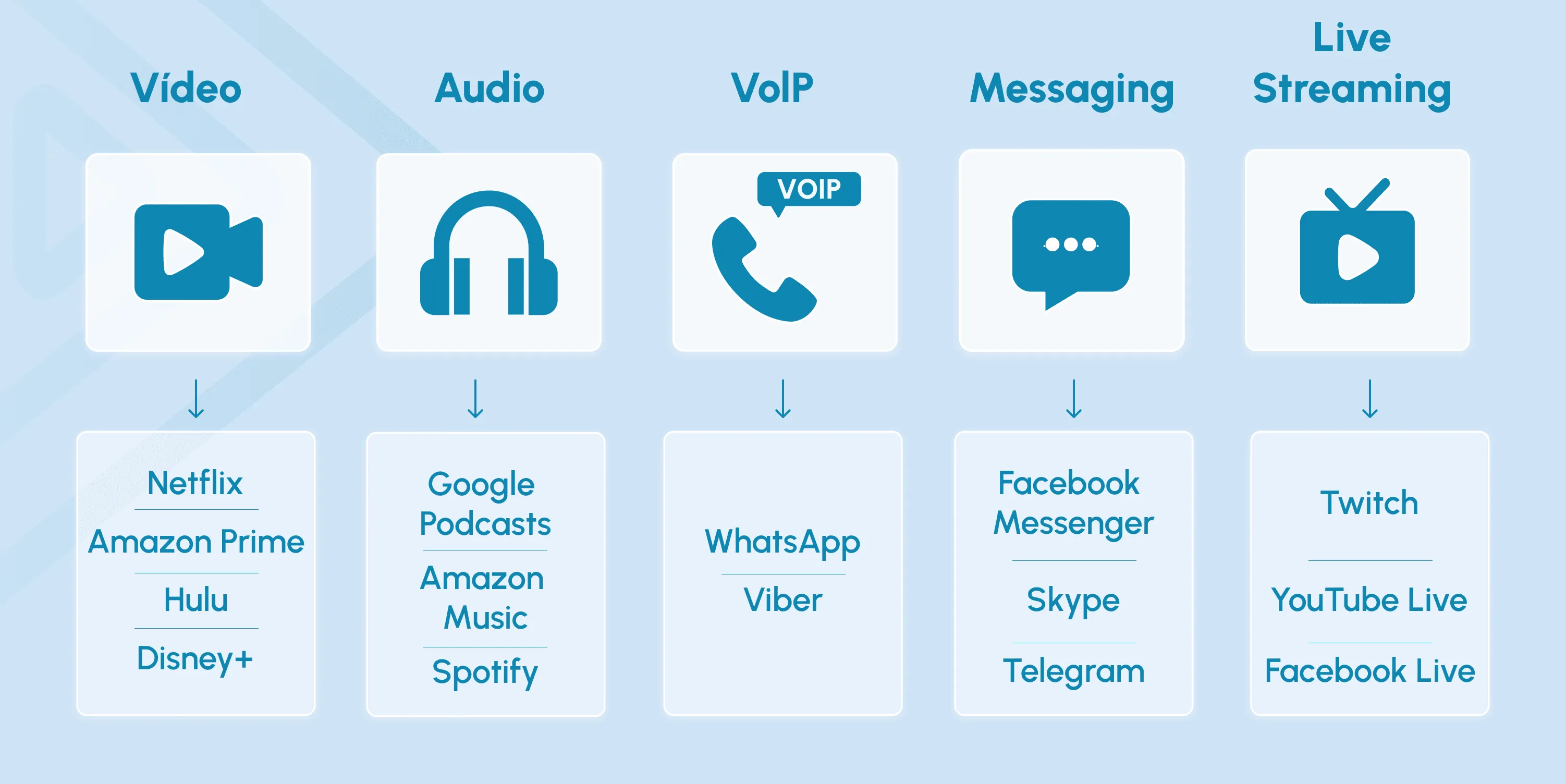
What is OTT? Benefits and 5 Types of OTT Services
OTT is revolutionizing how we consume entertainment. It is everywhere: on our mobile screens, Smart TVs, and computers.
But what is OTT, and why is it redefining the rules of engagement in media and content delivery?
This article will answer all of your questions about OTT. Ready to explore OTT in full form? Let’s dive in.

What is OTT?
OTT (Over-The-Top) delivers digital content, like movies and TV shows, via the Internet without relying on cable or satellite TV services.
This method allows for a wider audience reach, various content, and greater monetization strategies.
OTT Overview
- Over-the-top or OTT refers to delivering content via the internet directly to viewers, replacing traditional cable or satellite TV channels.
- OTT platforms have a worldwide reach without geographic restrictions or the need for traditional distribution systems, allowing users to access OTT content from anywhere and at any time using the internet.
- Users can watch or access OTT content on smart TVs, streaming boxes and sticks, mobile phones and tablets, or browsers. On-demand access allows users to watch their favorite films, shows, and other media content on their schedule.
How OTT Works
Let’s take a close look at the OTT technology and how it works.
Step 1. Sourcing OTT Content
OTT providers buy or license content from various sources, such as movie studios, TV networks, production companies, independent producers, and content creators.
This content may include movies, TV shows, documentaries, original programming, live streams, and user-generated content.
Step 2. OTT Content Optimization
The obtained content is then encoded into digital formats appropriate for online streaming. Video encoding and transcoding minimize file size while maintaining quality and optimizing content for multiple devices and network connection speeds.
The encoded content is then kept on physical servers or cloud-based systems for distribution.
Step 3. OTT Content Delivery
OTT platforms use Content Delivery Networks (CDNs) to provide content to viewers worldwide. CDNs are strategically located in different locations to minimize downtime, reduce latency, and boost performance. By executing content requests via the closest server, a CDN offers quicker loading times and more fluid playback.
The 5 Primary Types of OTT Services
The meaning of OTT content is best understood when considering the different types of OTT services available, which are detailed below.

Video Streaming OTT Services
Video streaming OTT services allow users to watch TV shows, movies, documentaries, and other original content on demand. Some well-known examples of OTT platforms under this category include Hulu, Amazon Prime Video, and Netflix. These OTT services typically operate on subscription-based or ad-supported models.
Audio and Music Streaming OTT Services
OTT music and audio streaming services offer real-time access to millions of songs, playlists, albums, and podcasts. Spotify and Apple iTunes are industry leaders in this space. Users can typically choose from freemium, ad-supported versions, or premium subscription-based options.
Live Streaming OTT Services
Live streaming has become a pillar among the news, sports, legal, business, and niche hobby categories. These OTT services provide real-time broadcasting of events, allowing viewers to engage with content creators and each other instantly. YouTube Live, Twitch, and Facebook Live are a few notable examples.
OTT Messaging Services
OTT messaging services like WhatsApp and Telegram have changed the way people communicate. Unlike traditional SMS or MMS, these services enable users to send text messages, share files, make phone calls, and engage in video calls over the internet—without the same geographic restrictions or costs associated with conventional telecommunication methods.
OTT VoIP Services
Voice over Internet Protocol (VoIP) services allow users to make audio or video calls using an internet connection. Zoom, Microsoft Teams, and Google Meet are major VoIP OTT platforms. These services offer high-quality audio and video and are used worldwide for both personal and professional communications.
OTT Platform Examples
Today, OTT platforms offer a wide range of online media, the majority of which includes video-on-demand content. Below are some examples of OTT platforms.
 Netflix is a subscription-based streaming service offering a vast library of movies, TV shows, documentaries, and original content.
Netflix is a subscription-based streaming service offering a vast library of movies, TV shows, documentaries, and original content.
Amazon Prime Video is part of the Amazon Prime subscription service and offers a wide selection of movies, TV shows, and original programming.
Disney+ features Disney, Marvel, Star Wars, and National Geographic content.
Hulu offers a combination of on-demand streaming and live TV. Its library includes TV shows, movies, original content, live sports, and news.
YouTube is a free, ad-supported platform for user-generated and professional content, including music videos, vlogs, tutorials, and more. YouTube also has a subscription model for ad-free viewing.
Apple TV+ is Apple's subscription-based streaming service that offers original movies, TV shows, and documentaries produced by Apple.
Peacock is NBCUniversal's streaming service, offering a mix of on-demand content, live sports, news, and original programming.
ESPN+ is Disney's sports-focused streaming service, offering live sports events, original shows, documentaries, and analysis.
Devices for OTT Platforms
Viewers access OTT content through dedicated applications or websites on various devices.
Here is a table showing the primary OTT devices:
| Device | Description | Best For |
|---|---|---|
| Smart TVs | Many smart TVs come with pre-installed OTT apps or allow users to download and install streaming applications from an app store. | Seamless streaming without extra devices. |
| Set-Top-Box (STB) Devices | Devices like Roku, Amazon Fire TV, Apple TV, and Google Chromecast enable streaming on non-smart TVs by connecting to the internet. | Upgrading older TVs for OTT access. |
| Smartphones and Tablets | Mobile devices running iOS or Android can stream OTT content via apps or web browsers, offering flexibility and portability. | On-the-go streaming and convenience. |
| Desktop and Laptop Computers | Users can watch OTT content through web browsers or desktop applications on their computers, often benefiting from larger screens. | Streaming at work or home while multitasking. |
| Gaming Consoles | Consoles like PlayStation, Xbox, and Nintendo Switch support OTT apps, combining gaming and entertainment in one device. | Gamers who also enjoy streaming content. |
OTT Benefits
An Extended Global Reach
OTT platforms allow businesses to reach a worldwide target audience without the restrictions of traditional distribution channels. This can help companies increase their brand visibility and attract new customers.
Additional Revenue Streams
Businesses can monetize their content on OTT platforms through various OTT revenue models, including subscription fees, advertising, pay-per-view, and merchandise sales. This diversified approach can help businesses generate additional income streams and maximize profitability.
High-Quality Audience Engagement
OTT platforms offer interactive features such as polls, quizzes, and social media integration, which can help businesses connect with their viewers meaningfully. This increased engagement can result in higher brand loyalty and customer satisfaction.
Detailed Insights
OTT platforms provide valuable reports and analytics on viewer behavior, engagement metrics, and content performance. These insights can help enterprises fully understand users, enhance content or marketing strategies, and make data-based decisions to improve ROI.
Brand Recognition and Trust
By creating high-quality, engaging content on OTT platforms, businesses can strengthen their brand presence and reputation while aspiring to become thought leaders in their industry. This can inspire ambition and confidence, helping companies build trust and credibility with their audience.
Better Control of Ad Campaigns and Content
OTT platforms empower businesses with greater flexibility and control over their content. Companies can customize their offerings, pricing, and distribution strategies according to their specific needs and goals for effective marketing.
OTT Content Protection and Management
Digital Rights Management (DRM)
DRM technologies ensure that content is securely delivered and can only be obtained by registered viewers on permitted devices.
OTT full-form platforms have content protection measures to prevent illegal access, piracy, and copyright infringement. These measures may involve using a DRM system to encrypt content, establish access controls for subscribers, and manage licensing agreements with content owners.
Content Management System (CMS)
OTT platforms include a CMS to categorize, organize, tag, and retrieve content. This, together with a user-friendly interface and intuitive navigation tools, helps users discover, browse, and easily navigate through content. So, a CMS integration is crucial to keep everything organized and accessible.
OTT Services vs. Traditional TV
Let’s compare OTT services with traditional TV to see how revolutionary OTT is.
| Feature | Traditional TV | OTT |
|---|---|---|
| Content delivery | Content is delivered via broadcast, cable, or satellite networks. | Content is delivered via the Internet. |
| Device Compatibility | Requires a television set. | Accessible on various devices, including smart TVs, smartphones, tablets, and computers, often with dedicated apps for each platform. |
| Distribution Model | Content is bundled into packages by providers, and viewers subscribe to these packages. | Content is typically offered on a subscription basis, but other models exist, like ad-based, pay-per-view, and hybrid options. Viewers have more flexibility in choosing specific services. |
| Content Access | Viewers are limited to the channels provided by their cable or satellite package. | Viewers can access different types of content from various providers, often on-demand. |
| Control and Interactivity | Limited control over what and when to watch, depending on programming schedules. | Greater control with on-demand access, pause, rewind, and fast-forward functionalities. Many OTT platforms also offer interactive features like personalized recommendations. |
| Advertising | Advertising is a primary revenue source, with commercials aired during scheduled breaks. | Advertising models vary, with some OTT services offering ad-supported tiers while others are ad-free and rely solely on subscription revenue. |
| Reachability | Typically limited to specific regions or countries due to infrastructure constraints. | Since content is delivered over the Internet, it can reach a global audience. However, licensing agreements and content restrictions may still apply in some cases. |
| Cost | Traditional TV can be more expensive due to bundled packages and additional fees for premium channels or equipment rental. | Generally more cost-effective for users, with fees often lower than traditional TV packages. However, costs can add up with subscriptions to multiple OTT services. |
inoRain’s OTT Solutions For Your Business Growth
Do you want to grow your business, diversify your revenue streams, and establish your brand as a thought leader? A partnership with inoRain can help you with that.
We provide customizable OTT solutions with innovative, out-of-the-box features designed to meet your specific OTT business and marketing needs.
With a simple, centralized dashboard and a multi-DRM system, you can reach global audiences and drive up your profits—all while protecting your content.
Want to reap the benefits of OTT with an affordable, efficient, and flawless OTT solution? Let inoRain help you out! Contact us today to get customized OTT services for your streaming business.
Conclusion
Digital streaming platforms have revolutionized how content is consumed and distributed, offering immense opportunities for broadcasters, video publishers, and content owners to thrive.
OTT technology’s ability to break down barriers and offer on-demand access to diverse content sets it apart from traditional television broadcasting, opening up endless possibilities for innovation and growth.
By leveraging the flexibility and accessibility OTT platforms provide, businesses can reach and target broader audiences, deliver personalized content experiences, and boost revenue.
Frequently Asked Questions
Founder / CEO
Andranik is the CEO and Co-Founder of inoRain OTT and the Co-Founder of HotelSmarters, specializing in next-generation streaming technologies and digital transformation for the hospitality sector. He focuses on building innovative, scalable solutions for video delivery, OTT monetization, and data-driven hospitality management. His work bridges technical sophistication with practical business impact, helping organizations modernize their digital ecosystems and improve operational efficiency.

How to Develop a Video Streaming App: Best Practices
Learn the basics of developing a modern video streaming app. This guide covers key best practices to help you build the right way from the start.

How to Make a Short Video App (2026 Complete Guide)
Learn how to build a short video app in 2026. Explore micro-drama trends, key features, monetization models, and step-by-step development insights.

OTT Advertising: Types, Best Practices, and Strategies
Over-the-top (OTT) advertising has transformed how brands connect with consumers.

